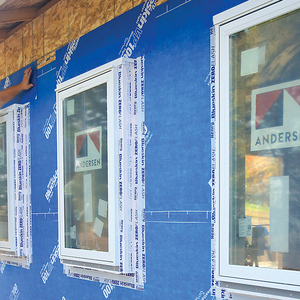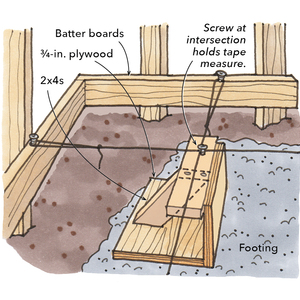Perhaps some of you have faced this situation and can tell me the best way to proceed. I am building a cabin on some land I own. The cabin is on a crawl space. It will be used a lot but there will be some periods of no use. The location is Missouri so we can get darn cold.
The question I have deals with the incoming water line. Where the water line is above the ground and in the crawl space it is subject to getting cold…now I know there are many homes with crawl spaces and the water line runs in just like mine…but my question is how do I make sure it does not freeze?
Ive had suggestions to install a whole house drain to use heat tape. Is heat tape really safe? The bathroom is where the water line will come into the building and it will be heated all the year.
Hopefully this isnt too confusing.



















Replies
There are all sorts of things you can do. First tell us more. Is the crawl space skirt insulated? Is the line buried outside of the house below frost line? Inside the crawl, does the line rest on the dirt? Could it be buried within the crawl? Is the dirt on the crawl at least fairly flat? Is the power reliable there?
One thought I had was you could bury the line a couple of inches in the dirt, then lay 4x8 sheets of 2" XPS foam over it along the length. This would have the effect of burying the line a couple of feet, in terms of where the frost level would be.
You can wrap a thermostatically controlled heat tape around the line where it comes up to go into the house. Safe, and the power isn't used when not needed.
Now stand carefully aside while the flood of other ideas come rushing through.
Personally, I'd insulate the foundation walls and floor joists and get a good vapor barrier so the crawl doesn't have to be vented. That should solve your problem.
Beer was created so carpenters wouldn't rule the world.
The crawl is insulated with 2 inch styro on the walls...
The water line is 3 feet deep and comes through the foundation and then comes up...
The distance from soil line in crawl to the floor at that point is about 2 feet.
The Crawl has an access door and is not vented. It has 6 mill plastic but in process of joists and subfloor it did get torn in a few places.
The building will only have continuous heat in the bathroom where the water line penetrates the floor and enters the house.
The water line is plastic pipe...flexible blue 1 inch line...
If you use heat tape, will it need to be in the crawl or can it go in the building on the pipe...stupid question I know. I just have visions of electrical shorts and all manner of bad things when I think of heat tape...is this stuff really safe? Sort of makes me feel like Ive done all this work right....footings, foundations, great planning and excellent carpentry...and then I use the equivelent of duct tape for a soffit.
I appreciate any and all ideas!
Do you know for a fact that the crawl gets below freezing? With a well insulated cover (the insulated foundation walls and floor joists) ground temps are often above freezing even in the cold climates. Simply think in terms of what's needed on open ground to keep the frost line at the surface. It's the same idea behind shallow frost protected foundations--add enough insulation to the ground cover and the frost line rises to the surface.
If the bathroom above is always heated, and you know the crawl is cold enough to freeze, I'd simply build a boxed shaft going from dirt to bathroom floor. A 12" wide shaft of 2" foam is all it would have to be. Clear out the floor insulation where the shaft meets the bathroom floor above, make sure air gaps are sealed well and I'll bet lunch that the temps in the shaft never get below freezing.
Beer was created so carpenters wouldn't rule the world.
Why not install a shutoff outside the house, like the ones in the sidewalk outside every house in suburbia. (I know this because I had a summer job in HS that required me to use a wood block and sledghammer to pound them down flush withthe sidewalk after the frost heaved them and created a trip hazard. There are a lot of them in a town of 50,000 people). They consist of a valve underground that is reached by a long pipe with a cap on top (called a curb box). You use a special wrench to reach it. Someone who supplies contractors who install municipal systems should be able to sell you what you need.
Without a provision to drain the water line you still have the potential to freeze under the crawlspace. We have the above mentioned valve setup in various water lines in corrals and pastures that aren't used full time. You basically need two valves, one to stop the supply and another to serve as a drain. We use a length of 10" PVC or whatever pipe you have big enough to house to valves stacked side by side and fill under the pipe with drain rock in order to allow for the house side to drain back. This assumes two things - your soil will perc and the house is uphill enough to get a siphon going to pull most of the water out of the line to a point it is well below the frost line.DO NOT USE GATE VALVES! Us a high quality, full flow Banjo brand plastic or all brass valves and weld up a little key that you can reach them with.This setup has worked for years on numerous installs, you can also blow the line out rather than drain it if you stub a pipe up out of the drain valve so it is easy to reach with the air compressor.
I built a Country Club, Club House that was to be shut down in the winter. There was to be no heat anywhere. It had bathrooms and a big kitchen. We installed a shutoff below the frost line and a connection for an air fitting. After the water was shut off and the water heater drained they hooked up a portable air compressor and blow out all the water lines. Sink and toilet traps need some RV antifreeze. This setup works well for them
The standard way of dealing with this is to install a thermostatically controlled heating wire inside the water line. Pyrotenax is the biggest manufacturer of these units. Depending on the length of the water line, the heating wire will be either 110v or 220v; if it's over 60 feet long, it'll be 220v.
There is a special cast-nylon T-head that comes with the wire installed in it; this is configured with an insert tang that goes into your water line. The wire comes out one end of the T and goes to the thermostat; the supply line to your pump goes off the other end of it.
It's very simple to install if your water line is straight and not too long. If it's got any serious bends in it, or if it's over 150 feet long, you'll have to stuff a fish tape through it or suck a light pull-cord through with a big shop vac and use that to help push/pull the fish tape through. Once you've got a fish through it, you can push and pull the heating wire from both ends (borrow some walkie talkies for the job if you can; it makes life a heck of a lot easier).
If you have to grease the wire to get it in, use an edible product such as vegetable oil or shortening since this is, after all, your potable water supply.
Dinosaur
How now, Mighty Sauron, that thou art not brought
low by this? For thine evil pales before that which
foolish men call Justice....